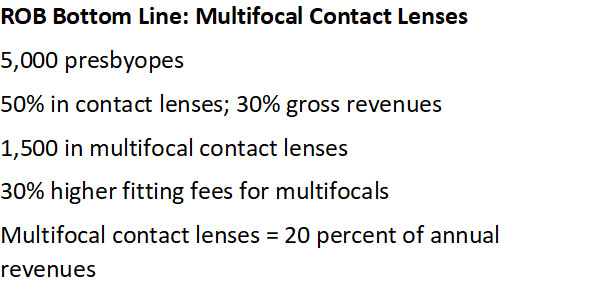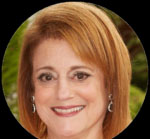Sponsored Content

By Susan Resnick, OD
August 21, 2019
Your contact-lens patients come with an array of needs. One of those growing needs is for seamless correction at all distances. In my practice, we have found a contact lens that delivers the visual quality and comfort which our presbyopic patients expect.
NaturalVue® Multifocal 1 Day Contact Lenses have been a boon to both our patients and practice.

New Design, New Opportunity to Serve Patients & Grow Profitability
We began prescribing NaturalVue Multifocal 1 Day four years ago. As early adopters of new technologies, we welcomed a new and unique design which might help us to better serve the increasing number of presbyopic patients desiring contact lenses.
While over the years there had been significant improvements in multifocal contact-lens offerings, there were still many patients who failed with aspheric and concentric designs requiring adaptation to “simultaneous vision.” NaturalVue Multifocal 1 Day features an extended depth-of-focus optical design which works differently.
Therefore, it offers the opportunity to capture those patients who were previously unsuccessful, in addition to emerging presbyopes.
Multifocal Success Story
Of the roughly 5,000 presbyopes in our practice, 50 percent wear contact lenses. Of those, approximately 1,500 wear multifocal contact lenses. Preventing contact-lens dropouts is critical to our contact lens specialty practice’s reputation and growth as “problem solvers,” as well as to our practice’s financial health. With contact-lens sales accounting for 30 percent of our gross revenues, we carefully select products that meet our standards for ocular health, vision and comfort.
The NaturalVue Multifocal 1 Day lens is manufactured from a material which has demonstrated longstanding comfort and safety. Today’s presbyopes favor products that meet their active lifestyle. They appreciate the value in upgrading to new technology, and have the disposable income to do so.
Strong ROI
The initial fitting visit for multifocal contact lenses typically takes about an hour. Because we work with highly trained technicians, who oversee pulling the lenses and the application, the patient is only in the exam-room chair for about 20 minutes. This includes discussing the options and procedures. Most of the time required is to allow the lenses to settle.
Our fitting fees for multifocals is 30 percent higher than fees for single-vision contact lenses. The fitting and sale of multifocal contact lenses generates roughly 20 percent of our annual revenues.
The good news is that there is no special instrumentation or added overhead cost to fitting multifocal contact lenses. We rely on our auto-refractor for quick review, but always start with a new subjective refraction and utilize loose trial lenses or flippers under binocular conditions in normal illumination for over refracting.
With a proper fee schedule, and informing the patient in advance of the fees, fitting multifocal contact lenses gives an immediate and long-lasting return on investment.
To encourage patients to “take the plunge,” we offer a 50 percent return on the fitting fee if they are not successful. Fortunately, our success rates are high, and this rarely occurs.
One of the main draws of the NaturalVue family of products, in addition to its many clinical advantages, is the proprietary nature of the brand. With the current competitive landscape in the contact-lens space, working with a brand that is not available through alternative suppliers ensures patient loyalty and financial opportunity.
More Choices, Greater Patient Satisfaction
Having more choices, particularly when the design platforms are significantly different, is the biggest factor in enabling us to fit more patients with multifocal contact lenses. Because there is no empirical way to perfectly predict which lens design or material will work for a given patient, it is not uncommon not to have to try more than one design. Working with at least two or three best-in-class products is the key to finding the best match for each patient.
Presbyopes not only have changes in accommodation; they have changes in the tear film and lid structure which can affect their ability to continue to wear contact lenses or to transition into lenses. Materials which address dry-eye symptoms, optical designs which offer the most natural vision, and contact lenses which handle easily, allow us to best serve this population.
Opportunity to Build Bond Through Patient Education
Patients can feel vulnerable and frustrated when they first notice their vision changing. Having an advanced-technology contact lens, like NaturalVue Multifocal 1 Day, gives us the opportunity to educate patients about how we can help them.
When discussing presbyopia with a patient, I first describe the “giveaway” behaviors such as needing more light to read, craning the neck back and moving things away to see them more clearly. Patients can easily relate to these and it gives them a better understanding that presbyopia is common. Because the term “presbyopia” is so foreign, I describe the vision changes as “loss in flexibility of focus” and explain that they now have two separate prescriptions: one for distance and one for near (or, for emmetropes, a need for their first prescription).
I then say, in a very positive tone: “The good news is that we have contact lenses that can restore the flexibility in your focus These lenses feel the same as your current lenses, but will significantly reduce your need for reading glasses.”
For patients new to contact lenses, I explain that multifocal contact lenses offer freedom from eyeglasses for activities and occasions of their choice or for full-time wear.
Many patients who have tried progressive spectacle lenses and have not adapted are concerned about their ability to adapt to multifocal contact lenses. I explain that there is no relationship between the two because contact lenses rest on the eye, and there is no peripheral distortion upon eye movement. I inform them that there is adaptation required for multifocal contact lenses, typically 3-7 days, but that it is not the same as adapting to eyeglasses.
For first-time progressive spectacle lens wearers, I tell them to allow a minimum of two weeks for adaptation. To ensure patients do not give up, I bring my new multifocal contact-lens fits back for a follow up 5-7 days later. This allows me to address any issues in a timely fashion. I always tell them upon initial fitting that “this is a work in progress,” so they know this is a more complex process than fitting singe-vision lenses.
We help our patients understand that their vision is different now, but still capable, with the right help, of being strong and clear. Products like NaturalVue Multifocal 1 Day enable us to make that case very easily.
 Susan Resnick, OD, is a partner with Drs. Farkas, Kassalow, Resnick & Associates in New York City. To contact her: sresnick525@gmail.com
Susan Resnick, OD, is a partner with Drs. Farkas, Kassalow, Resnick & Associates in New York City. To contact her: sresnick525@gmail.com
Doctor consulting disclosure: Dr. Resnick consults with Visioneering Technologies, Inc., and serves on its Speaker’s Bureau.
MKT-NVM-AP18





















